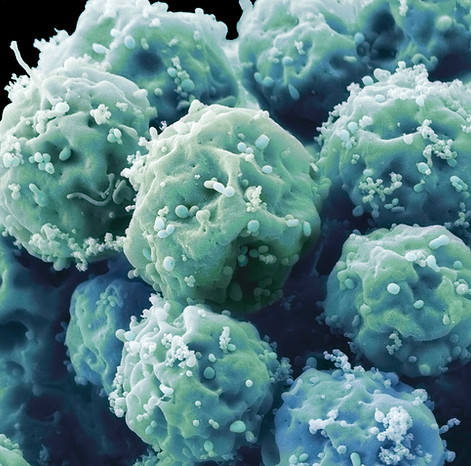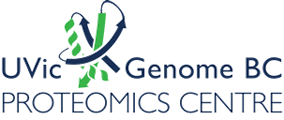
Research
Research Areas
The Proteomics Centre focuses on the application of mass spectrometry techniques to answer a wide variety of biological questions.

-
Targeted quantification using stable isotope standards
-
Untargeted identification and relative quantitation
-
Analysis of Post Translational Modifications (PTMs)
-
Targeted quantification
-
Custom targeted assay design
-
Untargeted identification and relative (label-free) quantification
-
Untargeted identification and relative (label-free) quantification
-
Development of in-house software tools
-
Advanced data analysis and visualization of ‘omics datasets
Instruments
One of the Proteomics Centre’s goals is assisting individual investigators in meeting their research objectives by providing access to instrumentation that may not be available in the investigator’s immediate environment. Our instruments include the Bruker timsTOF fleX MALDI-2 , Thermo LTQ-Orbitrap, Thermo Q Exactive Plus, Agilent 6495B Triple Quadrupole, and Sciex QTRAP 7500 Triple Quadrupole mass spectrometers, in addition to several high flow UPLC and nanoflow liquid chromatography systems.

Proteomics
The quantitative proteomics group specializes in the determination of "absolute" protein quantitation in biofluids (i.e., results in terms of concentrations rather than fold-changes). The Proteomics Centre has developed multiplexed assays multiple reaction monitoring (MRM) for five human biological samples, including plasma, dried blood spots, saliva, urine and cerebrospinal fluid (CSF). These highly multiplexed MRM assays are being used by the proteomics community to discover and validate potential biomarkers. We have recently expanded this area to include assays for mice, the most commonly used animal model for health research, with the goal of creating 3,000 protein assays in 20 different tissue types.

Metabolomics
Metabolomics is the study on quantitative measurements of the dynamic multi-parametric metabolic responses to pathological, physiological stimuli or genetic modifications in biological systems, and has evolved as the small molecule counterpart of transcriptomics and proteomics. It is a system-wide approach for investigating in vivo metabolic profiles that will provide information on environmental perturbation, pharmacology, toxicology, disease and gene function to dissect the biological pathways that involve in these processes. Metabolomics research at the Proteomics Centre is currently focused on developing and applying high-end mass spectrometry techniques to provide unbiased and high-throughput metabolic profiling of biofluids (plasma, serum, urine), cell culture, tissue and plant samples.
Targeted Metabolomics (Targeted Metabolite Analysis and Metabolic Profiling)
-
Amino acids, biogenic amines, and intermediates of amino acid metabolism and urine cycle
-
Metabolites involved in central carbon metabolism (glycolysis, gluconeogenesis, pentose phosphate pathway, the TCA cycle) --- sugar phosphates, nucleosides, enzyme cofactors, D/L-2-hydroxyglutarate, etc..
-
Low-molecular weight aldoses and ketoses
-
Bile acids, dihydroxy cholestenoic acid (DHCA), trihydroxy cholestanoic acid (THCA), and >40 potentially unknown [cp1] bile acids- Bioactive carboxylates, hydroxyl- and keto-carboxylates
-
Short-, medium- and long-chain fatty acids; acyl-carnitines; acetyl-coenzymes; acyl-glycines
-
Selected steroid hormones and sterols involved in cholesterol and steroid anabolism and catabolism: cortisol, 6β-OH cortisol, DHEA, DHEA sulphate, estrogens and androgens, etc.
-
Oxidative stress biomarkers in relation to lipid, protein and DNA/RNA peroxidation
-
Neurotransmitters
-
Thyroid hormones
-
Vitamin D and metabolites
-
Polyphenols
-
Naphthenic acids (>400)
Untargeted Metabolomics and Lipidomics
-
UPLC-FTMS and UPLC-MS/MS, in combination with multiple RP, ion-pairing and HILIC methods and multivariate statistics
MS Imaging
MALDI MSI is a histology technique that utilizes m/z for label-free detection of hundreds of biomolecules in tissue sections. It determines molecule’s relative abundance and spatial distribution while preserving tissue morphology.
Applications of MALDI MSI include but are not limited to, biomarker and small molecule discovery, drug pharmacodynamics and pharmacokinetics, infectious disease research, cancer research and diagnostics.
Basic MALDI-MSI workflow:
-
Matrix is deposited on thinly cryosectioned tissues
-
A virtual raster is created over the tissue section
-
Mass spectra are acquired in each pixel of the raster
-
Specialized software is used transform the raw spectra into images representing relative abundance and spatial distribution of molecules in the tissue
Note: pixel size determines the spatial resolution of the image (5 - 100 µm)
MS Imaging review:


Structural Proteomics
The Proteomics Centre is continuously developing and improving complementary MS-based techniques that allow the analysis of increasingly large proteins, including disease-related misfolded protein aggregates, as well as protein therapeutics and biosimilars. We are now extending these methods to protein-protein interaction studies in vivo, on the proteome-wide scale. The Proteomics Centre is continuing its pioneering work in structural proteomics by developing new methods for hydrogen-deuterium exchange (HDX) so that it can be used for larger proteins, and by developing new crosslinking reagents and software for more complete protein structural characterization. Recently, our research efforts have resulted in software which allows the use of these experimental results as constraints for improved molecular modeling.
These new methods and techniques facilitate many types of biological research, including studies of drug targets and the development of new drugs. We are also developing improved methods for the characterization of post-translational modifications (PTMs).

Bioinformatics
We focus on the automation of proteomics data analysis and the development of data processing algorithms and workflows. Our research interests are:
-
Novel methods for data analysis in targeted MRM proteomics
-
Automatic MRM assay design
-
Building libraries and databases for use in targeted proteomics approaches
-
Advanced data analysis and visualization in bottom-up and top-down proteomics
-
eScience applications in proteomics
-
Scaling up data analysis pipelines and automatic data processing workflows
-
Distributed computing applications in proteomics
For more information, please visit our bioinformatics Website at:
